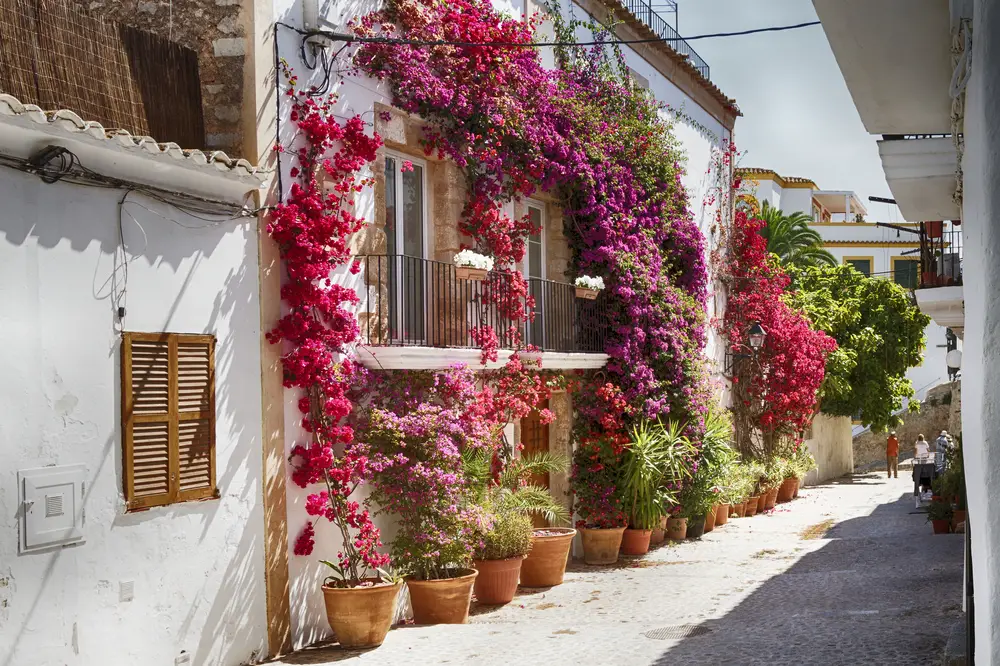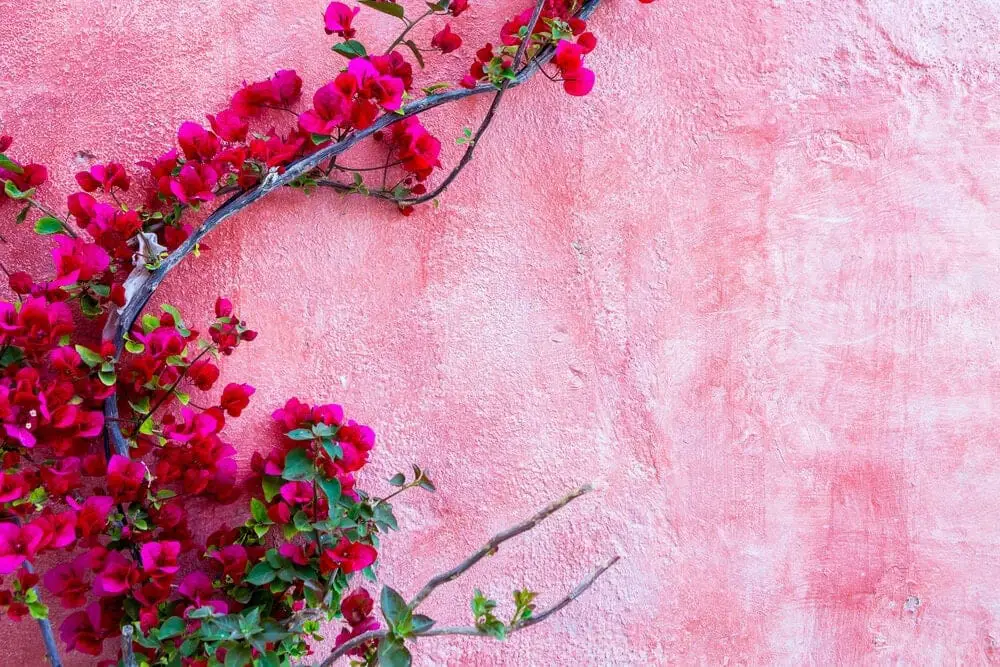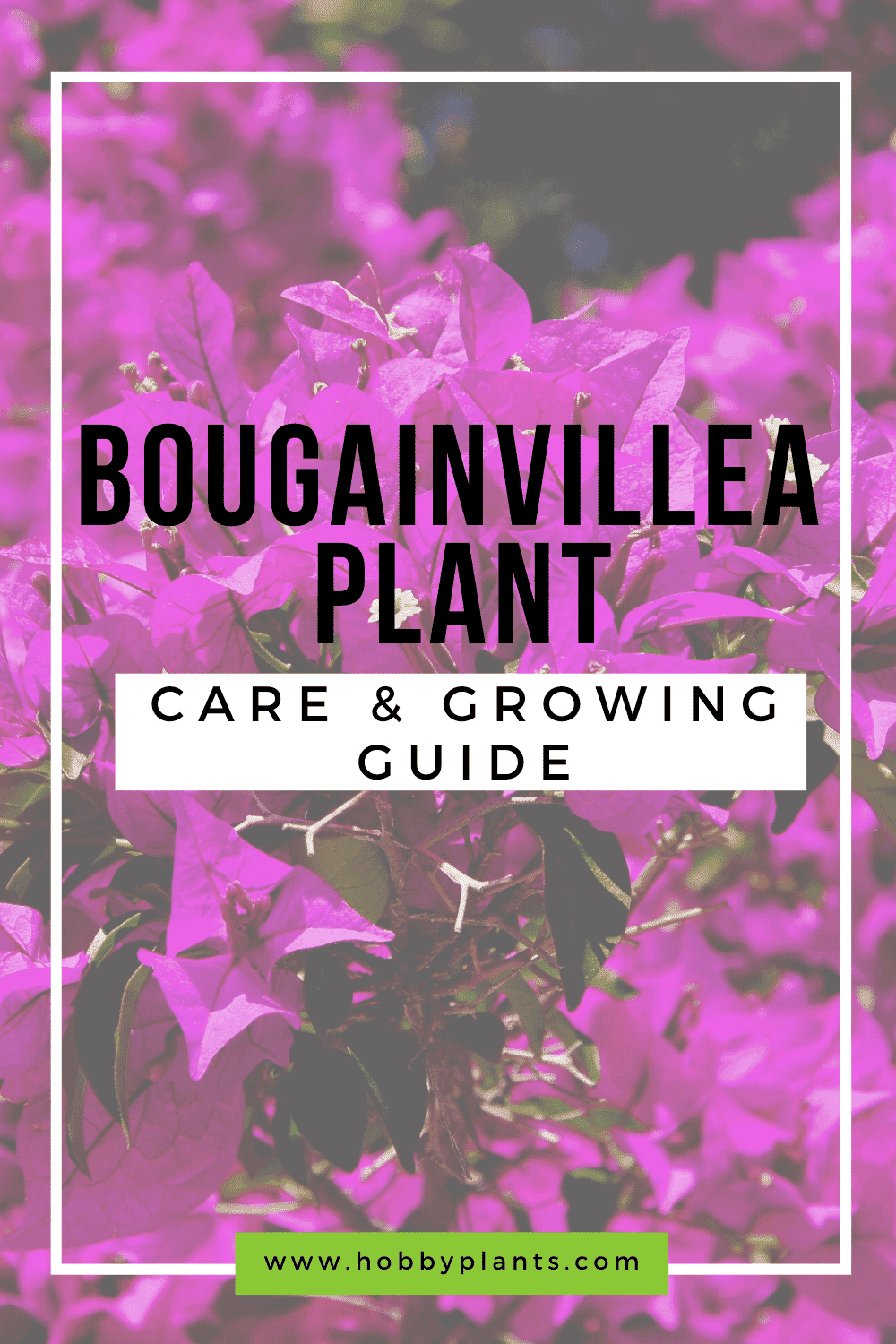This beautiful flowering plant is often used in decorations, both for buildings and offices, as well as private homes.
If cared for, this plant can grow to amazing lengths. Its stems and vines are moldable, and it can be inserted into trellises and arches. If the weather is temperate and it’s watered often, the flowers can bloom all year round. It is not a hard plant to maintain, but it does have a few important requirements.
Bougainvillea Plant Care Guide
1. Light Requirement
This plant loves to exposed to the sun and should get at least six hours of full direct sunlight a day. It can grow in indirect or partial light, but its bloom will not be as brilliant. If the light is low enough, the colors of the flowers may be faded, or they might not bloom at all
2. Water
Despite its many beautiful flowers all over its stems and leaves, this plant doesn’t need to be watered too often. It is meant to be drought resistant.
It should be completely soaked every couple of weeks instead of slightly watered every few days.
Don’t re-water it until the soil has dried. Water it more during the spring and summer than during the winter.
3. Climate and temperature
This plant and its flowers thrive best in areas that have warm winters and low winds. The best type of weather for this plant is warm and dry. Especially if it is to be outdoors all year long. It should be grown outside in hardiness zones nine and above.
It can be outside in colder, wetter weather, but it will need to be brought inside for the winter. It should not be outside if temperatures drop below 60 F.

4. Soil
This plant should be in soil that drains water away from its roots quickly. If it is in a container, perlite or sand should be added to the soil to improve drainage.
If it is in the ground, then the ground below its roots should be broken up to improve drainage as well.
The pH of the potting soil should be around 6.0 to 7 .0.
If it is to be fertilized, it should be fertilized every few months to feed the flowers and keep them blooming. Never fertilize it too much. When in doubt, fertilizer it less than recommended. Start fertilizing it at the beginning of spring and use a slow-release fertilizer is for the best results.
5. Repotting
This plant likes its roots to be a bit crowded, so don’t repot it until you see root coming out of the drainage holes. Choose a container that is only one size bigger than the current pot. When you place the plant in its new pot, keep the soil moist, and then when its flowers bloom, the soil should start drying out.
6. Speed of Growth
Bougainvillea Plants are very fast growers, even with the number of flowers it has to support. In a single year, it can grow up to three feet or more. The speed of its growth is affected by its growing conditions. In most climates that it can handle, it will still grow quickly.
7. Height and Spread
Because of its great growing ability, this plant can reach any size the gardener wants to keep it at. It can stay around 5 to 6 feet, or it can climb as high as 20 feet. The longer it grows, the more it will need support to keep it up, like a trellis or a gate. Its width is usually around two to three feet.
8. Trimming
Trim this plant after its first full bloom, which is usually in the late spring. If you fertilize it too late, like in the late summer or the fall, it can affect the number of flowers that bloom.
When you cut off a stem, cut it right before the node so that the node can produce leaves.
If there needs to be more growth at the top of the plant, trim off excess flowers and stems near the base of the plant.
If this plant is in a garden with other plants near it, it needs to be trimmed consistently. This pant has the ability to overwhelm other smaller plants and prevent them from receiving nutrients from the soil.

Is the Bougainvillea Plant plant poisonous?
The Bougainvillea plant is toxic to humans and animals, but it is not deadly. If you are not careful and you are stabbed by one of the thorns, you can develop a skin rash or a possible allergic reaction similar to that of poison ivy. If eaten, a human will get nausea, vomiting, and diarrhea.
Can Bougainvillea Plant Grow in Water?
No, it cannot be grown in water. This plant life of soil to be dried between waterings and doesn’t like too much humidity.
Does the Bougainvillea Plant have flowers, and how do I get them to bloom?
Yes, this plant is known for its flowers! To encourage a full bloom, keep it watered but never soaked. Also, feed it with fertilizer to give it all of the nutrients it needs. Keep it well trimmed and in a bright sunny place.
Learn more: Watermelon Peperomia Care & Growing Guide
Common Pests and diseases
- Leaftier Catapiler likes to lay their eggs and eat the leaves of this plant. If a few caterpillars are on the Bougainvillea Plant, then it will be fine, but too many caterpillars can eat up a lot of leaves and flowers and infest the plant.
- To remove these caterpillars, you can do one of two things. You can use an insecticide and kill them, or you can slowly find can pull each caterpillar off of the plant and relocate them somewhere far away. They turn into beautiful butterflies, so if you have the time, we recommend removing them.
- Leaf Cutter Bees are often attracted to this plant because of its many flowers. It likes to eat the leaves off of trees and plants, hence its name.
- But the leafcutter bee doesn’t infest or damage the plants that they eat from. They are there to pollinate flowers. So, this insect doesn’t need to be chased away or killed. Just let it pollinate the Bougainvillea plant and don’t bother it.
Also read:
- Flowering Almond Trees Care & Growing Guide
- Flaming Katy (Kalanchoe Blossfeldiana) Care & Growing Guide
Conclusion
- This plant is a quick grower and must be trimmed often.
- Instead of every few days, water it every few weeks.
- Don’t trim the plant until after its full bloom.
- This is a very popular decorative plant.

Victoria is the owner and main author of hobby plants. She loves spending her free time in her garden planting and taking care of her plants. Victoria hopes you enjoy the content here!
![Mother Of Thousands Plant [Complete Plant Care Guide] Mother Of Thousands Plant [Complete Plant Care Guide]](https://www.hobbyplants.com/wp-content/uploads/2022/07/mother-of-thousands-plant-300x158.jpg)
![Majesty Palm Plant Care: [Complete Beginner's Guide] Majesty Palm Plant Care: [Complete Beginner's Guide]](https://www.hobbyplants.com/wp-content/uploads/2022/08/majesty-palm-care-300x158.jpg)
![Exotic Angel Plant Care: [Complete Beginner's Guide] Exotic Angel Plant Care: [Complete Beginner's Guide]](https://www.hobbyplants.com/wp-content/uploads/2022/08/exotic-angel-plant-care-300x158.jpg)
![Snow White Waffle Plant: [Complete Care Guide] Snow White Waffle Plant: [Complete Care Guide]](https://www.hobbyplants.com/wp-content/uploads/2022/08/snow-white-waffle-plant-300x158.jpg)
![Waffle Plant Care: [Complete Beginner's Guide] Waffle Plant Care: [Complete Beginner's Guide]](https://www.hobbyplants.com/wp-content/uploads/2022/08/waffle-plant-300x158.jpg)
![Bird Of Paradise Plant Care: [Complete Beginner's Guide] Bird Of Paradise Plant Care: [Complete Beginner's Guide]](https://www.hobbyplants.com/wp-content/uploads/2022/08/bird-of-paradise-plant-300x158.jpg)
![Purple Passion Plant Care: [Complete Beginner's Guide] Purple Passion Plant Care: [Complete Beginner's Guide]](https://www.hobbyplants.com/wp-content/uploads/2022/08/purple-passion-plant-care-300x158.jpg)
![China Doll Plant Care: [Complete Beginner's Guide] China Doll Plant Care: [Complete Beginner's Guide]](https://www.hobbyplants.com/wp-content/uploads/2022/09/china-doll-plant-care-300x158.jpg)
![Polka Dot Plant Care: [Complete Beginner's Guide] Polka Dot Plant Care: [Complete Beginner's Guide]](https://www.hobbyplants.com/wp-content/uploads/2022/09/polka-dot-plant-300x158.jpg)
![Mona Lisa Lipstick Plant Care: [Complete Beginner's Guide] Mona Lisa Lipstick Plant Care: [Complete Beginner's Guide]](https://www.hobbyplants.com/wp-content/uploads/2022/09/lipstick-plant-mona-lisa-300x158.jpg)
![Yucca Cane Plant Care: [Complete Beginner's Guide] Yucca Cane Plant Care: [Complete Beginner's Guide]](https://www.hobbyplants.com/wp-content/uploads/2022/09/yucca-cane-plant-care-300x158.jpg)
![Bush On Fire Croton Plant Care: [Complete Beginner's Guide] Bush On Fire Croton Plant Care: [Complete Beginner's Guide]](https://www.hobbyplants.com/wp-content/uploads/2022/09/bush-on-fire-croton-300x158.jpg)